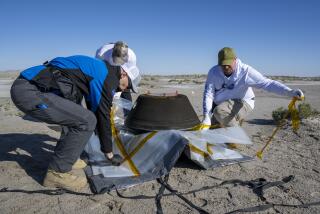Sahara rock appears to be first meteorite from Mars’ crust
- Share via
Scientists have identified what they believe to be the first meteorite to originate from the Martian crust, a 2.1-billion-year-old specimen that contains about 10 times more water than any other space rock from the Red Planet.
Discovered in the Sahara, the rock — called NWA 7034 — is unlike any of the 110-odd Martian meteorites yet found on Earth, according to a report published online Thursday by the journal Science. Experts said it provided an unprecedented close-up view of the Martian surface and may help scientists understand what NASA’s Curiosity and Opportunity rovers are seeing as they roam the terrain.
“This opens a whole new window on Mars,” said Munir Humayun, a cosmo-chemist at Florida State University in Tallahassee who was not involved in the study.
Though planetary scientists have sent several spacecraft to Mars — most recently Curiosity, which is equipped with an onboard chemical laboratory — there’s no substitute for a sample in hand, said study leader Carl Agee, director of the Institute of Meteoritics at the University of New Mexico in Albuquerque. Scientists on Earth can run sophisticated tests and glean a wealth of information about the rock’s history and the environment in which it formed — tests no rover could do.
NWA 7034 came to Agee in 2011 by way of a meteorite collector who bought it from a meteorite dealer in Morocco. The planetary scientist said he was immediately struck by the 319.8-gram sample, which is about the size of a baseball and twice as heavy.
Even though most space rocks become blackened on the outside during their blazing descent through the Earth’s atmosphere, they often remain light on the inside. NWA 7034, on the other hand, was dark all the way through, earning it the nickname “Black Beauty.”
“I had never seen anything like it,” Agee said.
Perplexed by the strange specimen, he put it on his bookshelf and let it sit there for about a month as he wrestled with the best way to approach his analysis. Once he got started, he examined the meteorite for nearly a year.
At first, NWA 7034 appeared to be very un-Mars-like. Laser fluorination revealed that its ratio of heavier-to-lighter oxygen isotopes, usually a handy fingerprint of a meteorite’s origins, didn’t match any of the Mars meteorites described in the scientific literature. Those meteorites seemed to come from volcanic deposits formed deep inside Mars, because their chemical makeup was different from the data sent back by rovers and spacecraft examining the Red Planet’s surface.
If Agee’s team had looked no further, the space rock might have been classified as an oddball piece of asteroid and quite possibly forgotten. But rubidium-strontium dating indicated that NWA 7034 was just 2.1 billion years old — far too young to come from an asteroid.
Meteorites that come from asteroids are typically more than 4 billion years old, since these small rocky bodies quickly cooled after the solar system’s formation. Planets, on the other hand, were volcanically active for much longer, and many of their rocks formed much later.
Black Beauty must have come from a planet, the team members concluded.
The meteorite had too much iron to have come from Mercury and it had too many traces of water to have come from Venus. But when they analyzed minerals called pyroxenes, they found that the ratio of iron to manganese did match those of other Martian meteorites.
Further analysis showed that Black Beauty was rich in sodium and potassium, giving it a striking resemblance to rocks on the Martian surface examined by Curiosity’s laser-shooting ChemCam instrument, Agee said, as well as those of Mars’ Gusev crater, which was explored by the NASA rover Spirit before it broke down in 2010.
That makes NWA 7034 a one-of-a-kind sample from the Martian crust, Agee said.
“What Carl Agee did was actually very courageous,” Humayun said. “They looked beyond what most people would have fallen for ... [and] recognized its Martian connection.”
Additional analysis showed that Black Beauty contained about 10 times more water than any other named Martian meteorite — about 6,000 parts per million.
That’s much more water than a rock its age should have. At 2.1 billion years old, it hails from the beginning of the Amazonian epoch, which is thought to be a dry chapter in Martian history.
Perhaps Mars was wetter for longer than scientists have thought, Agee said.
There are even hints of organic carbon in the meteorite, Humayun pointed out, although further study would need to be done to determine whether that material is of Martian origin or was acquired since arriving on Earth. The rock looks relatively fresh by Sahara standards, Agee said, guessing that it could have landed within the last few hundred years.
It’s unclear why most Martian meteorites have come from the planet’s interior, he added, though it may be that crustal rock is more fragile and less likely to survive a journey through space or entry into Earth’s atmosphere.
The find may inspire scientists to go back into their archives and reconsider other oddball meteorites. Perhaps there are more Martian specimens already in labs waiting to be identified, Humayun said.







